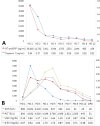Abstract
Respiratory syncytial virus (RSV) typically causes lower respiratory tract infections in children, and most patients recover successfully. However, some infants and young children can have a severe course of disease with respiratory failure, and extrapulmonary manifestations can occur in severe RSV disease. We report one case of severe RSV bronchiolitis complicated with acute myocarditis, fulminant hepatic failure, and disseminated intravascular coagulation.
Figures and Tables
Figure 1
(A) Chest X-ray before admission shows the disparity of inspiration between left and right lungs. (B) Chest X-ray at admission day shows hyperinflation in both lungs and haziness in left lung.

Figure 2
(A) Cardiac enzymes including N-terminal pro-B-type natriuretic peptide (NT-proBNP) and troponin I rapidly decreased after intravenous immunoglobulin administration on admission day. (B) Liver enzymes including aspartate aminotransferase (AST), alanine aminotransferase (ALT), total bilirubin (t-Bil), and direct bilirubin (d-Bil) peaked at admission day 2 to 5 and then gradually decreased. Abbreviations: HD, hospital day; OPD, outpatient department.

References
1. Staat MA. Respiratory syncytial virus infections in children. Semin Respir Infect. 2002; 17:15–20.

2. Checchia P. Identification and management of severe respiratory syncytial virus. Am J Health Syst Pharm. 2008; 65:23 Suppl 8. S7–S12.

3. Eisenhut M. Extrapulmonary manifestations of severe respiratory syncytial virus infection: a systematic review. Crit Care. 2006; 10:R107.
4. Njoku DB, Kliegman RM. Atypical extrapulmonary presentations of severe respiratory syncytial virus infection requiring intensive care. Clin Pediatr (Phila). 1993; 32:455–460.

5. Weisman L. Populations at risk for developing respiratory syncytial virus and risk factors for respiratory syncytial virus severity: infants with predisposing conditions. Pediatr Infect Dis J. 2003; 22:2 Suppl. S33–S37.

6. Thorburn K, Hart CA. Think outside the box: extrapulmonary manifestations of severe respiratory syncytial virus infection. Crit Care. 2006; 10:159.
7. Puchkov GF, Min'kovich BM. Respiratory syncytial infection in a child complicated by interstitial myocarditis with fatal outcome. Arkh Patol. 1972; 34:70–73.
8. Menchise A. Myocarditis in the setting of RSV bronchiolitis. Fetal Pediatr Pathol. 2011; 30:64–68.

9. Bowles NE, Ni J, Kearney DL, Pauschinger M, Schultheiss HP, McCarthy R, et al. Detection of viruses in myocardial tissues by polymerase chain reaction. evidence of adenovirus as a common cause of myocarditis in children and adults. J Am Coll Cardiol. 2003; 42:466–472.

10. Drucker NA, Colan SD, Lewis AB, Beiser AS, Wessel DL, Takahashi M, et al. Gamma-globulin treatment of acute myocarditis in the pediatric population. Circulation. 1994; 89:252–257.

11. Eisenhut M, Thorburn K. Hepatitis associated with severe respiratory syncytial virus-positive lower respiratory tract infection. Scand J Infect Dis. 2002; 34:235.

12. Eisenhut M, Thorburn K, Ahmed T. Transaminase levels in ventilated children with respiratory syncytial virus bronchiolitis. Intensive Care Med. 2004; 30:931–934.

13. Griffin N, Keeling JW, Tomlinson AH. Reye's syndrome associated with respiratory syncytial virus infection. Arch Dis Child. 1979; 54:74–76.

14. Al-Maskari N, Mohsin J, Al-Maani A, Al-Macki N, Al-Ismaili S. Atypical presentations of respiratory syncytial virus infection: case series. Sultan Qaboos Univ Med J. 2016; 16:e86–e91.





 PDF
PDF ePub
ePub Citation
Citation Print
Print


 XML Download
XML Download